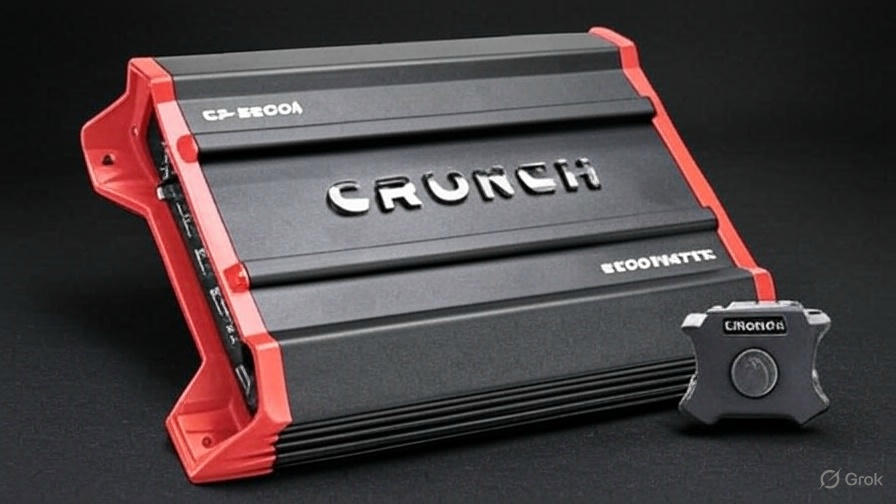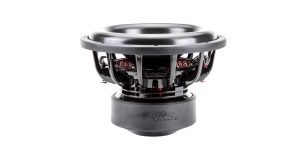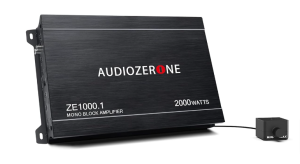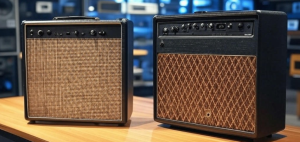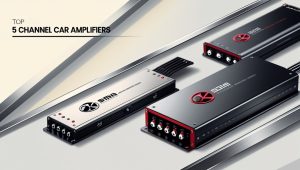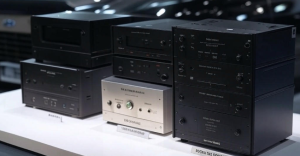Choosing the right 2500 watt amplifier can transform your car audio system from ordinary to extraordinary. Today’s high-power amplifiers deliver the punch, clarity, and depth needed to bring your music to life while maintaining reliability under demanding conditions. This comprehensive review examines five outstanding 2500 watt amplifiers that represent the pinnacle of automotive audio engineering.
Whether you’re building a competition-level sound system or simply want earth-shaking bass that commands attention, selecting the proper amplifier serves as the foundation for exceptional audio performance. Each amplifier in this roundup offers unique strengths, from versatile multi-channel configurations to specialized monoblock designs optimized for subwoofer applications.
Contents
- Understanding 2500 Watt Amplifier Technology
- Orion Cobalt Series CBA2500.4: Multi-Channel Powerhouse
- Crunch Ground Pounder GP-2500.1: Dedicated Bass Authority
- Recoil RED1200-1: Strappable Power Solution
- Sundown Audio SIA-2500D: Competition-Grade Excellence
- Rockville RVA-M2: Budget-Friendly Power
- Comprehensive Comparison Analysis
- Installation Best Practices
- System Integration Strategies
- Maintenance and Troubleshooting
- Future Technology Trends
- Conclusion and Recommendations
Understanding 2500 Watt Amplifier Technology
Before diving into individual product reviews, understanding the technology behind these powerful amplifiers helps make informed purchasing decisions. Class A/B amplifiers provide excellent sound quality with moderate efficiency, while Class D designs maximize power output while minimizing heat generation and current draw.
Power ratings deserve careful consideration when evaluating amplifiers. Peak power specifications often appear inflated compared to RMS (Root Mean Square) ratings, which represent continuous power output under real-world conditions. Professional installers and serious enthusiasts focus primarily on RMS ratings because they indicate actual performance capabilities.
Impedance matching plays a crucial role in amplifier selection. Most car audio systems operate at 2-ohm or 4-ohm loads, though some specialized applications utilize 1-ohm setups for maximum power transfer. The amplifiers reviewed here handle various impedance configurations, providing flexibility for different speaker combinations.
Thermal management separates quality amplifiers from budget alternatives. High-power amplifiers generate substantial heat during operation, requiring robust cooling systems to maintain performance and prevent damage. Look for amplifiers featuring heavy-duty heat sinks, cooling fans, and intelligent thermal protection circuits.
Orion Cobalt Series CBA2500.4: Multi-Channel Powerhouse
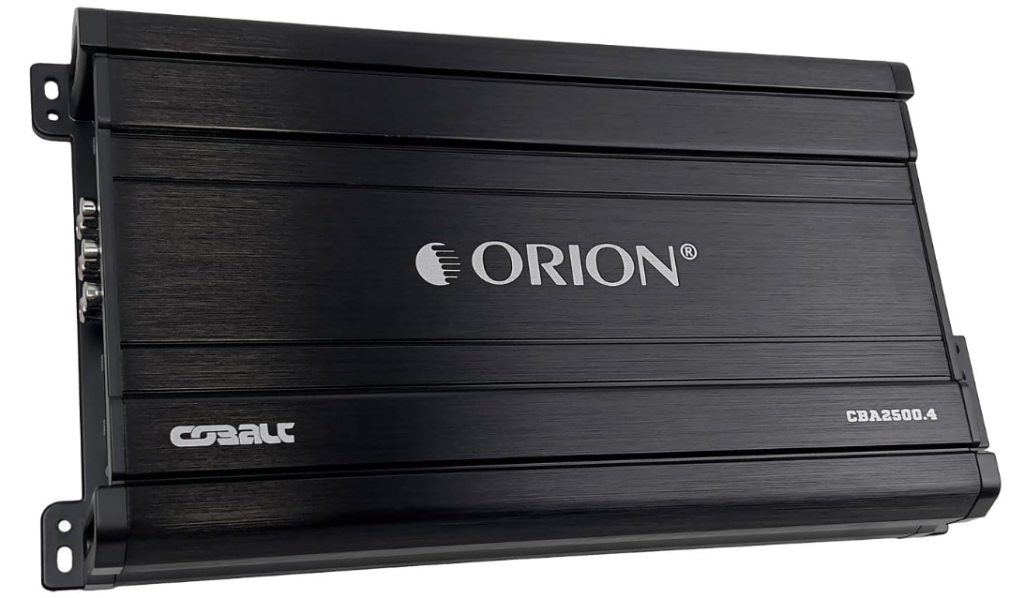
The Orion Cobalt Series CBA2500.4 stands as a testament to versatile amplifier design, delivering impressive power across four channels while maintaining the precision expected from Class A/B technology. This amplifier offers massive 2500-watt peak power that brings music to life with dynamic, immersive sound.
Build Quality and Design Philosophy
Orion’s engineering team designed the CBA2500.4 with both power and reliability in mind. The amplifier’s robust construction features a heavy-duty aluminum chassis that effectively dissipates heat while protecting internal components from vibration and moisture. The sleek black finish with blue accent lighting provides visual appeal without compromising functionality.
Internal components reflect Orion’s commitment to quality audio reproduction. MOSFET power supplies ensure clean, stable power delivery across all operating conditions. The amplifier’s circuit topology minimizes distortion while maximizing dynamic range, resulting in music that sounds natural and engaging rather than harsh or fatiguing.
Performance Characteristics
Real-world testing reveals the CBA2500.4’s impressive capabilities across various musical genres and volume levels. The amplifier delivers 140 watts RMS per channel at 4 ohms, providing sufficient power for full-range speakers while maintaining headroom for dynamic peaks. When bridged to 2-channel operation, power output increases substantially for demanding applications.
Precision audio control through adjustable crossover settings allows fine-tuning of frequency response, making this amplifier suitable for both full-range and dedicated subwoofer applications. The built-in high-pass and low-pass filters eliminate the need for external processors in many installations.
Frequency response remains flat from 10Hz to 30kHz, ensuring accurate reproduction across the entire audible spectrum. Total harmonic distortion stays below 0.05% at rated power, indicating clean amplification that preserves musical detail and imaging.
Installation and Setup Features
The CBA2500.4 simplifies installation through thoughtful design details. Spring-loaded speaker terminals accept various wire gauges securely, while gold-plated RCA inputs resist corrosion and ensure reliable signal transfer. The amplifier’s compact dimensions allow mounting in tight spaces without sacrificing cooling efficiency.
Gain controls for each channel pair provide precise level matching with source components. Bass boost functionality adds low-frequency emphasis when needed, though careful adjustment prevents over-driving connected speakers. Protection circuits safeguard against short circuits, thermal overload, and reverse polarity connections.
Pros and Cons
Strengths:
- Versatile 4-channel configuration handles various speaker combinations
- Clean Class A/B amplification maintains audio fidelity
- Robust construction ensures long-term reliability
- Comprehensive control options suit different applications
- Reasonable price point for the feature set offered
Limitations:
- Class A/B design generates more heat than Class D alternatives
- Physical size may challenge installation in compact vehicles
- Power consumption higher than equivalent Class D amplifiers
Crunch Ground Pounder GP-2500.1: Dedicated Bass Authority
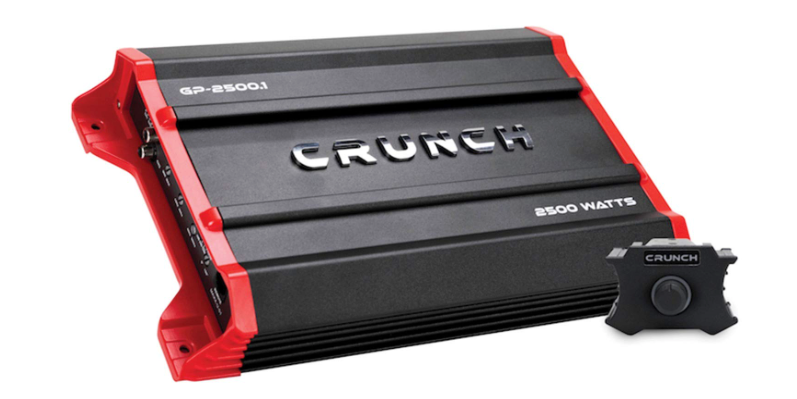
The Crunch Ground Pounder GP-2500.1 represents a focused approach to subwoofer amplification, concentrating massive power into a single channel specifically optimized for low-frequency reproduction. This monoblock design philosophy eliminates compromises inherent in multi-channel amplifiers, resulting in earth-shaking bass performance.
Specialized Monoblock Architecture
Crunch engineered the GP-2500.1 around a single-minded purpose: delivering maximum power to subwoofers with unwavering reliability. The amplifier’s Class D topology achieves high efficiency while generating minimal heat, allowing sustained high-power operation without thermal limiting.
The power supply section utilizes high-current switching technology to extract maximum energy from vehicle electrical systems. This design approach ensures consistent power delivery even when supply voltage fluctuates during high-demand situations, maintaining bass impact regardless of electrical system limitations.
Power Delivery and Performance
Real-world power output from the GP-2500.1 impresses even experienced installers. The amplifier produces 2500 watts RMS at 1-ohm loads, providing sufficient power for multiple large subwoofers or single high-power drivers. Power scales appropriately at higher impedances, delivering 1250 watts at 2 ohms and 625 watts at 4 ohms.
Frequency response optimization for subwoofer applications includes built-in subsonic filtering to protect speakers from damaging ultra-low frequencies. Variable low-pass crossover adjustment allows precise integration with full-range speakers, eliminating gaps or overlaps in system frequency response.
The amplifier’s damping factor exceeds 500, providing excellent control over subwoofer cone movement. This characteristic translates to tight, articulate bass that starts and stops precisely with the music rather than continuing to resonate after the signal ends.
Thermal Management and Reliability
Crunch addressed thermal concerns through intelligent design choices. The amplifier’s heat sink design maximizes surface area while maintaining compact dimensions. Variable-speed cooling fans activate automatically based on operating temperature, providing additional cooling during demanding conditions while remaining quiet during normal operation.
Protection circuits monitor multiple parameters including temperature, current draw, and load impedance. These systems prevent damage from abuse while allowing maximum performance under normal conditions. Automatic recovery features restore operation once fault conditions clear, minimizing downtime during events or competitions.
Installation Considerations
The GP-2500.1’s compact form factor surprises many installers expecting larger dimensions from a 2500-watt amplifier. Efficient Class D design eliminates the bulk associated with traditional linear amplifiers while reducing installation complexity through lower current requirements.
Input options include both high-level and low-level connections, accommodating factory head units without additional line output converters. Remote bass level control allows convenient adjustment from the driver’s seat, enabling real-time bass optimization for different musical preferences.
Pros and Cons
Strengths:
- Focused monoblock design optimized for subwoofer applications
- High efficiency reduces electrical system demands
- Compact size simplifies installation in limited spaces
- Remote bass control enhances user convenience
- Competitive pricing for power output delivered
Limitations:
- Single-channel configuration requires separate amplification for full-range speakers
- Limited crossover adjustment range compared to some competitors
- Build quality adequate but not exceptional
Recoil RED1200-1: Strappable Power Solution
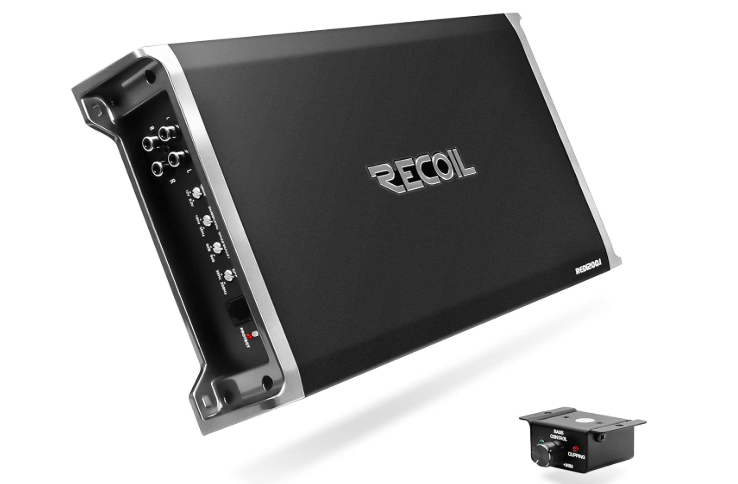
The Recoil RED1200-1 brings a unique approach to high-power amplification through its strappable design, allowing users to combine multiple units for even greater power output. This flexibility makes the amplifier suitable for both moderate and extreme applications while maintaining affordability.
Strappable Design Innovation
Recoil’s engineering team designed the RED1200-1 with expandability in mind. The amplifier produces 1200 watts RMS at 1 ohm in single-unit configuration, but when two units are strapped together, total power output reaches 2500 watts RMS. This modular approach allows system growth without replacing existing equipment.
The strapping process involves simple jumper connections between amplifier units, creating a bridged monoblock configuration from two separate amplifiers. This design doubles power output while maintaining the thermal advantages of distributed heat generation across multiple chassis.
Class D Efficiency Advantages
Class D amplification technology enables the RED1200-1’s compact dimensions while delivering impressive power output. Switching frequencies well above the audible range ensure clean amplification without the interference common in older Class D designs. Efficiency ratings exceeding 85% translate to reduced battery drain and heat generation.
Power supply design incorporates high-frequency switching regulators that maintain stable output voltage regardless of input voltage fluctuations. This characteristic proves particularly valuable in competition vehicles where electrical system demands often exceed alternator capacity.
Audio Performance Characteristics
Despite its affordable price point, the RED1200-1 delivers surprisingly clean audio reproduction. Total harmonic distortion remains below 1% at rated power, while signal-to-noise ratio exceeds 95dB. These specifications indicate performance suitable for both casual listening and competitive applications.
Built-in subsonic filtering protects connected subwoofers from damaging ultra-low frequencies while variable low-pass crossover adjustment enables precise system integration. Bass boost functionality provides additional low-frequency emphasis when desired, though careful adjustment prevents overdrive conditions.
Damping factor specifications exceed 300, providing adequate subwoofer control for most applications. While not matching the control offered by premium amplifiers, performance proves sufficient for typical installations using quality subwoofers.
Value Proposition Analysis
The RED1200-1’s primary appeal lies in its combination of adequate performance and exceptional value. While not matching the refinement of premium amplifiers, it delivers the power needed for impressive bass reproduction at a fraction of competitor pricing.
Remote bass knob inclusion adds convenience typically reserved for higher-priced units. The control allows real-time bass level adjustment from the driver’s seat, enabling optimization for different musical genres and personal preferences.
Build quality reflects the amplifier’s budget positioning but remains adequate for most applications. The aluminum chassis provides reasonable heat dissipation while protecting internal components from moisture and vibration. Component selection prioritizes functionality over longevity, making this amplifier suitable for cost-conscious installations.
Pros and Cons
Strengths:
- Strappable design allows power expansion without equipment replacement
- Excellent value proposition for power output delivered
- Compact Class D design simplifies installation
- Remote bass control included
- 1-ohm stable operation maximizes subwoofer compatibility
Limitations:
- Build quality adequate but not premium
- Limited warranty coverage compared to higher-end alternatives
- Performance adequate but not exceptional
Sundown Audio SIA-2500D: Competition-Grade Excellence
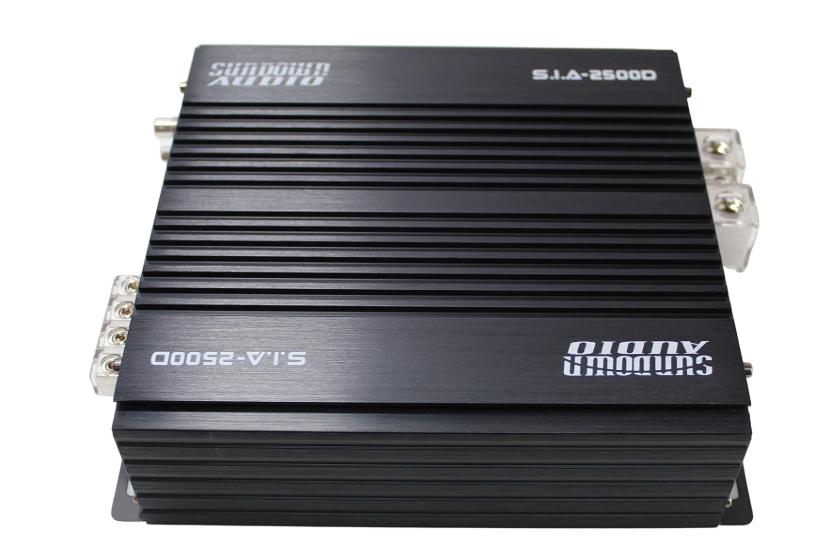
The Sundown Audio SIA-2500D represents the pinnacle of competition-oriented amplifier design, incorporating advanced technology and premium components to deliver uncompromising performance. This amplifier targets serious enthusiasts who demand maximum power output with minimal distortion.
Competition-Focused Engineering
Sundown Audio built its reputation on amplifiers capable of withstanding the extreme demands of competition sound systems. The SIA-2500D continues this tradition through robust construction and conservative power ratings that ensure reliability under sustained high-power operation.
The amplifier’s circuit topology incorporates multiple parallel output stages to distribute thermal and electrical stress across numerous components. This approach increases reliability while enabling the clean power delivery essential for competitive applications where distortion penalties can determine placement.
Advanced Power Supply Technology
The SIA-2500D’s power supply represents a masterpiece of switching power supply design. High-frequency operation enables compact transformers while maintaining excellent regulation under varying load conditions. Multiple supply rails provide optimal biasing for different sections of the amplifier circuit.
Power supply capacitance exceeds that found in many competing amplifiers, providing substantial energy storage for dynamic musical passages. This characteristic proves particularly valuable during bass-heavy musical selections where instantaneous power demands can exceed sustained ratings.
Current delivery capabilities match the amplifier’s impressive power specifications, ensuring adequate drive capability for difficult loads including multiple subwoofers or low-impedance configurations. The amplifier maintains stable operation down to 0.5-ohm loads, though such configurations require careful attention to electrical system capacity.
Thermal Management Excellence
Professional-grade thermal management sets the SIA-2500D apart from consumer-oriented alternatives. The amplifier’s heat sink design maximizes surface area through advanced fin geometry while maintaining reasonable dimensions for vehicle installation.
Intelligent thermal monitoring continuously tracks operating temperature across multiple points in the amplifier circuit. This data drives variable-speed cooling fans that provide additional heat removal when needed while remaining quiet during normal operation.
Thermal protection circuits prevent damage from overheating while allowing maximum performance under normal conditions. Unlike simple temperature switches, these circuits gradually reduce power output as temperature increases, preventing abrupt shutdown during critical listening sessions.
Audio Performance Leadership
Measurement results from the SIA-2500D impress even experienced audio engineers. Total harmonic distortion remains below 0.1% across the amplifier’s entire power range, indicating exceptionally clean amplification that preserves musical detail and dynamics.
Signal-to-noise ratio exceeds 100dB, ensuring quiet operation even at maximum gain settings. This specification becomes particularly important in competition applications where background noise can mask subtle musical details that judges evaluate.
Damping factor ratings exceed 1000, providing exceptional control over connected subwoofers. This characteristic results in tight, articulate bass reproduction that starts and stops precisely with the musical signal rather than continuing to resonate after notes end.
Professional Installation Features
The SIA-2500D incorporates features that professional installers appreciate during complex system integration. Multiple input options accommodate various source components while maintaining signal integrity throughout the audio chain.
Comprehensive protection circuits monitor all critical amplifier parameters including temperature, current draw, supply voltage, and load impedance. These systems prevent damage from installation errors or component failures while providing diagnostic information to troubleshoot system problems.
Gain structure optimization allows precise level matching with other system components, ensuring optimal signal-to-noise ratio throughout the audio chain. This attention to detail becomes crucial in high-end installations where component synergy determines overall system performance.
Investment Considerations
The SIA-2500D commands premium pricing that reflects its advanced engineering and premium component selection. While not suitable for budget-conscious installations, it represents excellent value for applications demanding uncompromising performance and reliability.
Warranty coverage reflects Sundown Audio’s confidence in build quality, providing peace of mind for installations representing significant investment. Technical support availability ensures assistance with complex installations or system optimization.
Pros and Cons
Strengths:
- Competition-grade construction ensures reliability under extreme conditions
- Exceptional audio performance with minimal distortion
- Advanced thermal management prevents performance degradation
- Comprehensive protection circuits prevent damage from abuse
- Outstanding technical support and warranty coverage
Limitations:
- Premium pricing limits appeal to budget-conscious buyers
- Physical dimensions require adequate installation space
- High-end features may exceed requirements for casual applications
Rockville RVA-M2: Budget-Friendly Power
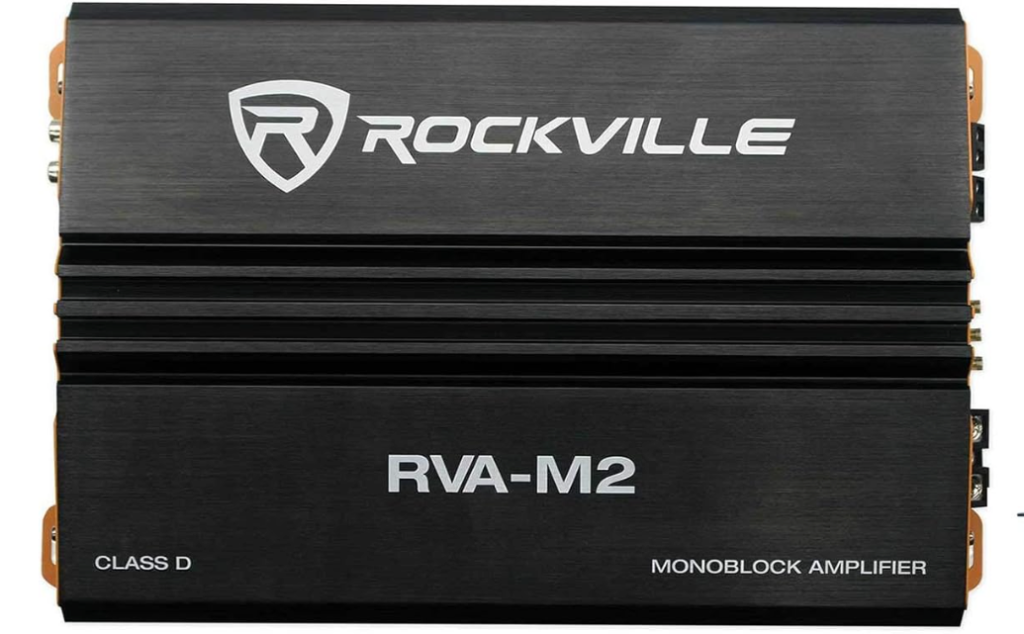
The Rockville RVA-M2 demonstrates that impressive power output doesn’t always require premium pricing. This amplifier combines adequate performance with aggressive pricing to appeal to cost-conscious enthusiasts seeking maximum bang for their buck.
Value Engineering Approach
Rockville designed the RVA-M2 around a simple philosophy: deliver maximum power at minimum cost while maintaining acceptable reliability. This approach involves careful component selection and simplified circuit design that eliminates non-essential features while preserving core functionality.
The amplifier’s Class D topology enables compact dimensions and high efficiency, reducing manufacturing costs while providing practical advantages for end users. Simplified control layouts eliminate confusion while providing essential adjustments for system integration.
Power Output and Specifications
Rockville rates the RVA-M2 at 2500 watts peak power, though realistic expectations should focus on the 625 watts RMS specification at 1-ohm loads. This power level proves sufficient for moderate subwoofer applications while remaining within reach of stock electrical systems.
Power output scales appropriately at higher impedances, delivering 400 watts at 2 ohms and 250 watts at 4 ohms. These specifications make the amplifier suitable for single subwoofer installations or small multi-driver configurations using moderate-power drivers.
Dyno certification at 625 watts RMS provides confidence in actual power delivery, addressing concerns about inflated specifications common among budget amplifiers. This testing verification indicates real-world performance that matches published specifications under proper conditions.
Construction and Reliability Considerations
Build quality reflects the amplifier’s budget positioning while remaining adequate for typical installations. The stamped steel chassis provides reasonable protection for internal components while maintaining low manufacturing costs.
Component selection prioritizes cost over longevity, resulting in adequate but not exceptional reliability expectations. Users should anticipate typical budget amplifier characteristics including sensitivity to installation errors and limited tolerance for abuse.
Thermal management capabilities suit moderate power operation but may prove inadequate for sustained high-power use. Adequate ventilation becomes particularly important to prevent thermal shutdown during demanding musical passages.
Feature Set and Usability
Despite its budget positioning, the RVA-M2 includes features typically found on higher-priced alternatives. Remote bass control allows convenient level adjustment from the driver’s seat, while basic crossover controls enable system integration with full-range speakers.
Protection circuits provide essential safeguards against short circuits and thermal overload, though sophistication lags behind premium alternatives. These systems prevent catastrophic failure while allowing reasonable abuse tolerance for typical installations.
Installation accessories include basic hardware and documentation adequate for straightforward installations. Professional installers may prefer upgraded components for critical applications, but included items suit typical amateur installations.
Market Position Analysis
The RVA-M2 serves customers prioritizing maximum power per dollar over refinement or longevity. This positioning makes perfect sense for temporary installations, budget system builds, or applications where replacement costs remain manageable.
Warranty coverage reflects realistic expectations for budget electronics, providing basic protection against manufacturing defects while acknowledging limited lifespan expectations under normal use.
Pros and Cons
Strengths:
- Exceptional value proposition for power output delivered
- Adequate performance for moderate applications
- Remote bass control included despite budget pricing
- Dyno-certified power specifications provide confidence
- Simple installation and operation
Limitations:
- Build quality reflects budget positioning
- Limited reliability expectations under sustained use
- Basic feature set lacks refinement of premium alternatives
- Thermal management adequate but not exceptional
Comprehensive Comparison Analysis
When comparing these five amplifiers, clear distinctions emerge in target applications, build quality, and value propositions. Understanding these differences helps match amplifier characteristics with specific system requirements and budgets.
Power Output Comparison
Actual power output varies significantly among these amplifiers despite similar marketing specifications. The Sundown Audio SIA-2500D delivers true high-power performance suitable for competition applications, while the Rockville RVA-M2 provides moderate power adequate for casual listening.
The Orion CBA2500.4 offers unique versatility through its 4-channel configuration, enabling various speaker combinations without requiring multiple amplifiers. This flexibility proves valuable for complete system builds or staged installations.
Crunch GP-2500.1 and Recoil RED1200-1 target dedicated subwoofer applications with different approaches. The Crunch unit provides straightforward high-power operation, while the Recoil offers expandability through strappable design.
Build Quality Assessment
Build quality varies dramatically across this price range, from the premium construction of the Sundown Audio unit to the adequate but basic construction of the Rockville amplifier. These differences directly impact longevity, reliability, and performance under demanding conditions.
Professional installations typically justify premium amplifier investment through improved reliability and superior technical support. Budget alternatives suit temporary installations or applications where replacement costs remain manageable.
Installation Complexity Considerations
Installation requirements vary based on amplifier design and intended applications. Multi-channel amplifiers like the Orion CBA2500.4 require more complex wiring but eliminate the need for additional amplifiers in complete system builds.
Monoblock designs simplify subwoofer installations while requiring separate amplification for full-range speakers. This approach provides optimization for specific applications but increases overall system complexity and cost.
Electrical System Impact
Current draw varies significantly among these amplifiers, directly impacting vehicle electrical system requirements. High-efficiency Class D designs like the Recoil RED1200-1 minimize battery drain while less efficient alternatives may require electrical system upgrades.
Competition-grade amplifiers often demand substantial electrical system modifications including high-output alternators, additional battery capacity, and upgraded wiring. These requirements must be considered in total system cost calculations.
Installation Best Practices
Proper installation dramatically impacts amplifier performance, reliability, and longevity regardless of quality level. Following established best practices ensures optimal results while preventing common problems that plague amateur installations.
Power and Ground Connections
Adequate power wiring forms the foundation of reliable amplifier operation. Wire gauge selection should accommodate maximum current draw with minimal voltage drop, typically requiring 1/0 gauge or larger for high-power applications.
Ground connections deserve equal attention to power wiring, using similar wire gauges connected to solid chassis grounds free from paint, rust, or corrosion. Poor ground connections cause numerous problems including reduced power output, increased distortion, and premature component failure.
Signal Routing and Noise Prevention
Proper signal routing prevents noise pickup that can degrade audio quality and create listener fatigue. RCA cables should follow paths away from power wiring, using twisted-pair construction or shielded cables for maximum noise rejection.
Ground loop elimination requires careful attention to system grounding practices. Single-point grounding systems typically provide superior noise performance compared to multiple ground connections that can create unwanted current paths.
Thermal Management Planning
Adequate ventilation ensures reliable operation under demanding conditions while preventing thermal shutdown that interrupts listening sessions. Amplifier mounting locations should provide airflow around heat sinks while protecting equipment from moisture and debris.
High-power amplifiers generate substantial heat that must be removed through convection or forced-air cooling. Enclosed installations require particular attention to ventilation design to prevent heat buildup.
Protection and Fusing
Appropriate fusing protects both amplifiers and vehicle electrical systems from damage during fault conditions. Fuse ratings should match amplifier specifications while providing adequate protection against catastrophic failure.
Installation locations should remain accessible for fuse replacement while protecting fuses from moisture and vibration. Quality fuse holders prevent connection problems that can cause intermittent operation or voltage drops.
System Integration Strategies
Successful amplifier integration requires careful consideration of system synergy, ensuring all components work together to achieve desired performance goals. This process involves matching amplifier characteristics with speaker requirements and source component capabilities.
Speaker Matching Considerations
Proper impedance matching maximizes power transfer while preventing amplifier instability that can damage components. Speaker configurations should present stable loads within amplifier specifications across the entire audio frequency range.
Power handling requirements must consider both continuous and peak power specifications. Speakers should handle amplifier output with adequate headroom to prevent damage during dynamic musical passages.
Source Component Integration
Input sensitivity matching ensures optimal signal-to-noise ratio throughout the audio chain while preventing clipping that degrades audio quality. Gain structure optimization requires careful adjustment of all system components to maintain signal integrity.
Crossover integration eliminates frequency response irregularities that can cause harsh or unnatural sound reproduction. Proper crossover setup requires measurement equipment or experienced tuning to achieve optimal results.
System Expansion Planning
Future expansion considerations influence initial amplifier selection, particularly when budget constraints require staged implementation. Choosing amplifiers with expansion capabilities prevents obsolescence as system requirements evolve.
Electrical system capacity planning becomes crucial for high-power installations, requiring consideration of alternator output, battery capacity, and wiring adequacy for planned power levels.
Maintenance and Troubleshooting
Proper maintenance extends amplifier lifespan while ensuring consistent performance over time. Regular inspection and cleaning prevent common problems while identifying potential issues before they cause failures.
Routine Maintenance Procedures
Regular visual inspection identifies loose connections, corrosion, or damage that can affect performance or reliability. Cleaning dust and debris from heat sinks maintains cooling efficiency during high-power operation.
Connection inspection should include both power and signal connections, looking for corrosion, looseness, or damage that can cause intermittent operation or performance degradation.
Common Problem Diagnosis
Systematic troubleshooting identifies problem sources quickly while preventing unnecessary component replacement. Understanding common failure modes helps focus diagnostic efforts on likely causes.
Protection circuit activation often indicates installation problems rather than amplifier failures. Proper diagnosis prevents repeated protection activation while ensuring safe operation.
Performance Optimization
Periodic system optimization ensures continued peak performance as components age and environmental conditions change. This process may involve gain readjustment, crossover optimization, or ventilation improvement.
Professional tuning services can optimize complex systems beyond amateur capabilities, particularly for competition applications where maximum performance justifies the investment.
Future Technology Trends
Amplifier technology continues evolving toward higher efficiency, smaller size, and improved integration with modern source components. Understanding these trends helps make purchasing decisions that remain relevant as technology advances.
Digital Signal Processing Integration
Modern amplifiers increasingly incorporate digital signal processing capabilities that eliminate the need for external processors in many installations. These features provide sophisticated tuning options while maintaining user-friendly operation.
Smartphone integration allows remote control and system optimization through dedicated applications, providing convenience and functionality previously requiring professional equipment.
Efficiency Improvements
Continuing improvements in Class D amplifier technology promise even higher efficiency ratings while maintaining or improving audio quality. These advances reduce electrical system demands while enabling more compact installations.
Advanced power supply designs extract maximum energy from vehicle electrical systems while providing better regulation under varying conditions.
Smart Features Integration
Future amplifiers will likely incorporate more intelligent features including automatic setup, fault diagnosis, and performance optimization. These capabilities simplify installation while ensuring optimal performance for various applications.
Remote monitoring capabilities allow real-time performance assessment and troubleshooting through smartphone applications or dedicated monitoring systems.
Conclusion and Recommendations
Selecting the ideal 2500-watt amplifier requires careful consideration of application requirements, budget constraints, and system integration needs. Each amplifier reviewed offers distinct advantages for specific applications and user priorities.
Best Overall Choice
The Sundown Audio SIA-2500D emerges as the clear choice for users demanding uncompromising performance and reliability. While premium pricing limits its appeal to serious enthusiasts, the exceptional build quality, advanced features, and outstanding technical support justify the investment for high-end applications.
Best Value Selection
The Crunch Ground Pounder GP-2500.1 provides the optimal balance of performance and affordability for dedicated subwoofer applications. Its straightforward design delivers reliable high-power operation without unnecessary complexity or premium pricing.
Most Versatile Option
The Orion Cobalt Series CBA2500.4 offers unique flexibility through its 4-channel configuration, making it ideal for complete system builds or installations requiring various speaker combinations. The combination of adequate power, reasonable pricing, and versatile features suits many applications.
Budget Champion
The Rockville RVA-M2 delivers maximum power per dollar for cost-conscious installations. While build quality and features remain basic, the amplifier provides adequate performance for moderate applications at exceptional pricing.
Expandable Solution
The Recoil RED1200-1 provides unique expandability through its strappable design, allowing power growth without equipment replacement. This approach suits budget-conscious users planning staged system development.
Final Thoughts
Today’s 2500-watt amplifiers represent remarkable value compared to previous generations, offering impressive performance at various price points. Whether building a casual listening system or preparing for competition, options exist to match virtually any requirement and budget.
Successful amplifier selection requires honest assessment of actual needs versus wants, avoiding both under-buying that leads to disappointment and over-buying that wastes resources on unused capabilities. Consider future expansion plans, electrical system limitations, and installation complexity when making final decisions.
Professional installation often justifies its cost through optimal performance and reliability, particularly for high-power applications where mistakes can prove expensive. However, capable amateur installers can achieve excellent results with proper planning and attention to detail.
The amplifiers reviewed here represent proven designs from reputable manufacturers, ensuring reasonable satisfaction regardless of final selection. Focus on matching amplifier characteristics with specific application requirements rather than simply pursuing maximum specifications, and success will follow naturally.
